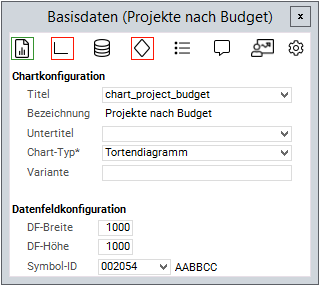Chart Customizer
Information
- The chart customizer allows you to configure charts.
- In the web client this function is available from release 1.0.0 and in the desktop client from C 39.5.31.
- The chart customizer is opened in a dialog window and consists of several modules in which different attributes of a chart can be defined:
Access
- There are different ways to open the chart customizer:
- Via the Chart Configuration by Work Area:
- Login with the customizer role and select Chart Customizer → Chart Configurations in the user menu.
- Open the Chart Configurations by Work Area module and open the required chart by clicking on the link in the Chart Type field.
- Via the Chart Configuration by Work Area module:
- Login with the customizer role and select Chart Customizer → Chart Configurations in the user menu.
- Open the Chart Configurations Direct Editing module and open the required chart by clicking on the link in the Chart type field.
- From a module:
- Open the user module in which you want to edit/create a chart.
- Open the eponymous module via the Tools menu item → Create/Edit Charts.
- Open the required chart by clicking on the link in the Chart type field.
- Via the Chart Configuration by Work Area:
Details
- If the chart customizer is opened in the web client, the changes made to the charts are displayed in real-time in the system.
- The module currently opened in the chart customizer has a green outline in the toolbar.
- If a module is not relevant for the chart type currently opened, it has a red outline.
Note
- In order to copy the value of a data field to the respective chart, you have to enter the Python ID of the field. If you want to copy the DF heading instead, you have to prefix the Python ID with an @.
- Values which do not contain a prefix or which do not correspond to a valid Python ID from the respective data area are interpreted as fixed strings and automatically receive $ as a prefix.
Example

Create New Chart
Information
- In order to be able to create a chart in a module, the module must contain a Button/IronPython data field with "py” DF behavior.
Procedure
- Open the module in which you want to create the chart.
- Select the Tools menu item → Create/Edit Charts.
- If there is only one data field on which a chart can be created, the chart customizer with the Basic Data module will be opened directly.
- If there are several data fields which can be used as charts ("py” DF behavior) or if there already are chart configurations in the module, the Create/Edit Charts module will be opened first.
- Click on the link in the DI field in the Create new chart area in order to open the chart customizer with the Basic Data module.
- Define the chart attributes in the respective dialog modules of the chart customizer.
Note
- New charts are created with "Line" chart type.
Edit Chart
Procedure
- Open the module which contains the chart you want to edit.
- Select the Tools menu item → Create/Edit Charts.
- If there only is one chart configuration, it is directly opened in the chart customizer with the Basic Data module.
- If there are several chart configurations, the Create/Edit Charts module will be opened first.
- Click on the link in the Chart type field in order to open the chart customizer with the Basic Data module.
- Define the chart attributes in the respective dialog modules of the chart customizer.
Delete Chart
Procedure
- Open the module which contains the chart to be deleted.
- Select the Tools menu item → Create/Edit Charts.
- If there only is one chart configuration, it is directly opened in the chart customizer with the Basic Data module.
- If there are several chart configurations, the Create/Edit Charts module will be opened first.
- Click on the link in the Chart type field in order to open the chart customizer with the Basic Data module.
- Click on the
 to open the Chart Variant module.
to open the Chart Variant module. - Enter the variant to be deleted in the Variant field if required.
- If you do not enter a variant, the base variant will be deleted.
- Click on Delete to delete the chart.
- If there are several charts, you have to delete them individually.
-
Page: